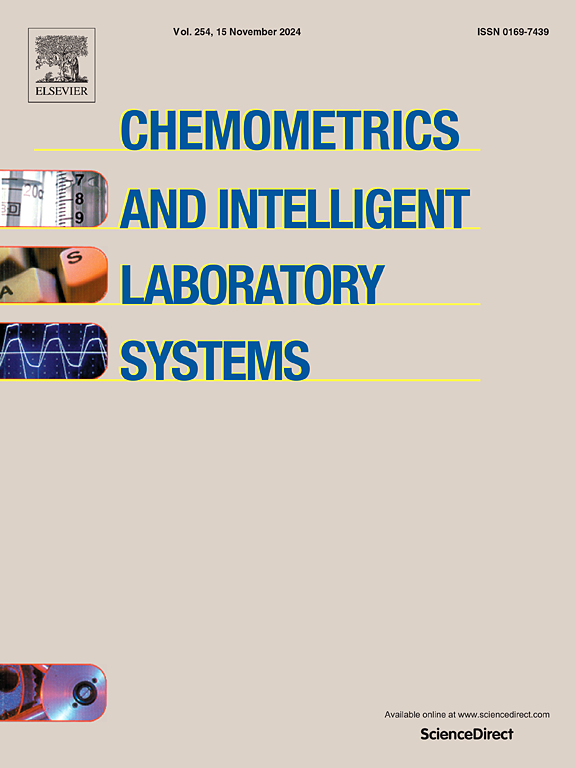Artificial neural network-assisted study on thermohydrodynamic behavior of tetrahybrid nanofluids in a porous stretching cylinder
IF 3.8
2区 化学
Q2 AUTOMATION & CONTROL SYSTEMS
Chemometrics and Intelligent Laboratory Systems
Pub Date : 2025-09-19
DOI:10.1016/j.chemolab.2025.105537
引用次数: 0
Abstract
This study explores the flow dynamics and thermal characteristics of a tetrahybrid nanofluid over a stretching cylinder, considering the effects of a magnetic field and internal heat generation. Two distinct tetrahybrid nanofluids are examined for the comparative analysis of temperature, pressure, velocity distributions, skin friction, and heat transfer performance: one composed of Ag+SiO+TiO+AlO suspended in kerosene oil, and the other consisting of Au+CuO+FeO+ Multi-Walled Carbon Nanotubes () dispersed in water. The governing equations are solved numerically using the fourth-order Runge–Kutta method coupled with a shooting strategy and artificial neural network (ANN). Parametric studies revealed that the Au+ CuO+FeO+Multi-Walled Carbon Nanotubes () nanofluid exhibited superior thermal performance, characterized by higher Nusselt numbers, while the Ag+SiO+TiO+AlO nanofluid provided enhanced momentum transport and higher velocity profiles. Au+CuO+FeO+Multi-Walled Carbon Nanotubes () shows stronger pressure resistance near the surface, while Ag+SiO+TiO+AlO yields greater skin friction due to higher effective viscosity. An artificial neural network (ANN) was trained using Bayesian regularization to accurately predict skin friction and Nusselt number values. The Au+CuO+FeO+Multi-Walled Carbon Nanotubes () nanofluid is well-suited for high-efficiency thermal management systems, including electronic cooling, solar collectors, and magnetic heat delivery. In contrast, Ag+SiO+TiO+ AlO nanofluid offers advantages in polymer extrusion, coating, and lubrication processes. The inclusion of porous media effects further broadens applicability to geothermal systems, packed-bed reactors, and smart heat exchangers. ANN predictions closely match the numerical results with correlation coefficients above 0.9999, demonstrating its reliability as a surrogate model.
人工神经网络辅助下多孔拉伸圆柱体中四杂化纳米流体热流体动力学行为的研究
本研究探讨了四杂交纳米流体在拉伸圆柱体上的流动动力学和热特性,考虑了磁场和内部热产生的影响。对两种不同的四杂化纳米流体进行了温度、压力、速度分布、表面摩擦和传热性能的对比分析:一种由悬浮在煤油中的Ag+SiO2+TiO2+Al2O3组成,另一种由分散在水中的Au+CuO+Fe3O4+多壁碳纳米管(MWCNTs)组成。采用四阶龙格-库塔法结合射击策略和人工神经网络对控制方程进行了数值求解。参数研究表明,Au+ CuO+Fe3O4+多壁碳纳米管(MWCNTs)纳米流体表现出优异的热性能,具有较高的努塞尔数,而Ag+SiO2+TiO2+Al2O3纳米流体具有增强的动量传递和更高的速度分布。Au+CuO+Fe3O4+多壁碳纳米管(MWCNTs)在近表面表现出更强的耐压性,而Ag+SiO2+TiO2+Al2O3由于更高的有效粘度而产生更大的表面摩擦。采用贝叶斯正则化方法训练人工神经网络,准确预测皮肤摩擦和努塞尔数。Au+CuO+Fe3O4+多壁碳纳米管(MWCNTs)纳米流体非常适合于高效率的热管理系统,包括电子冷却,太阳能集热器和磁热输送。相比之下,Ag+SiO2+TiO2+ Al2O3纳米流体在聚合物挤出、涂层和润滑过程中具有优势。多孔介质效应的加入进一步扩大了地热系统、填料床反应器和智能热交换器的适用性。人工神经网络预测结果与数值结果吻合较好,相关系数均在0.9999以上,证明了其作为替代模型的可靠性。
本文章由计算机程序翻译,如有差异,请以英文原文为准。
求助全文
约1分钟内获得全文
求助全文
来源期刊
CiteScore
7.50
自引率
7.70%
发文量
169
审稿时长
3.4 months
期刊介绍:
Chemometrics and Intelligent Laboratory Systems publishes original research papers, short communications, reviews, tutorials and Original Software Publications reporting on development of novel statistical, mathematical, or computer techniques in Chemistry and related disciplines.
Chemometrics is the chemical discipline that uses mathematical and statistical methods to design or select optimal procedures and experiments, and to provide maximum chemical information by analysing chemical data.
The journal deals with the following topics:
1) Development of new statistical, mathematical and chemometrical methods for Chemistry and related fields (Environmental Chemistry, Biochemistry, Toxicology, System Biology, -Omics, etc.)
2) Novel applications of chemometrics to all branches of Chemistry and related fields (typical domains of interest are: process data analysis, experimental design, data mining, signal processing, supervised modelling, decision making, robust statistics, mixture analysis, multivariate calibration etc.) Routine applications of established chemometrical techniques will not be considered.
3) Development of new software that provides novel tools or truly advances the use of chemometrical methods.
4) Well characterized data sets to test performance for the new methods and software.
The journal complies with International Committee of Medical Journal Editors'' Uniform requirements for manuscripts.

 求助内容:
求助内容: 应助结果提醒方式:
应助结果提醒方式:


